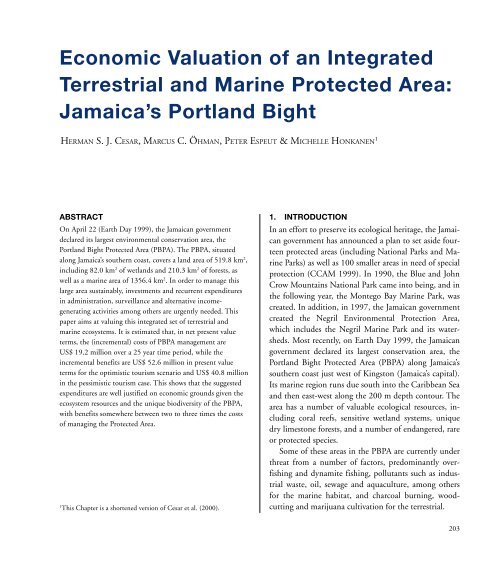Create successful ePaper yourself
Turn your PDF publications into a flip-book with our unique Google optimized e-Paper software.
Economic Valuation <strong>of</strong> an Integrated<br />
Terrestrial and Marine Protected Area:<br />
Jamaica’s Portland Bight<br />
HERMAN S. J. CESAR, MARCUS C. ÖHMAN, PETER ESPEUT & MICHELLE HONKANEN 1<br />
ABSTRACT<br />
On April 22 (Earth Day 1999), the Jamaican government<br />
declared its largest environmental conservation area, the<br />
Portland Bight Protected Area (PBPA). The PBPA, situated<br />
along Jamaica’s southern coast, covers a land area <strong>of</strong> 519.8 km 2 ,<br />
including 82.0 km 2 <strong>of</strong> wetlands and 210.3 km 2 <strong>of</strong> forests, as<br />
well as a marine area <strong>of</strong> 1356.4 km 2 . In order to manage this<br />
large area sustainably, investments and recurrent expenditures<br />
in administration, surveillance and alternative incomegenerating<br />
activities among others are urgently needed. This<br />
paper aims at valuing this integrated set <strong>of</strong> terrestrial and<br />
marine ecosystems. It is estimated that, in net present value<br />
terms, the (incremental) costs <strong>of</strong> PBPA management are<br />
US$ 19.2 million over a 25 year time period, while the<br />
incremental benefits are US$ 52.6 million in present value<br />
terms for the optimistic tourism scenario and US$ 40.8 million<br />
in the pessimistic tourism case. This shows that the suggested<br />
expenditures are well justified on economic grounds given the<br />
ecosystem resources and the unique biodiversity <strong>of</strong> the PBPA,<br />
with benefits somewhere between two to three times the costs<br />
<strong>of</strong> managing the Protected Area.<br />
1<br />
This Chapter is a shortened version <strong>of</strong> Cesar et al. (2000).<br />
1. INTRODUCTION<br />
In an effort to preserve its ecological heritage, the Jamaican<br />
government has announced a plan to set aside fourteen<br />
protected areas (including National Parks and Marine<br />
Parks) as well as 100 smaller areas in need <strong>of</strong> special<br />
protection (CCAM 1999). In 1990, the Blue and John<br />
Crow Mountains National Park came into being, and in<br />
the following year, the Montego Bay Marine Park, was<br />
created. In addition, in 1997, the Jamaican government<br />
created the Negril Environmental Protection Area,<br />
which includes the Negril Marine Park and its watersheds.<br />
Most recently, on Earth Day 1999, the Jamaican<br />
government declared its largest conservation area, the<br />
Portland Bight Protected Area (PBPA) along Jamaica’s<br />
southern coast just west <strong>of</strong> Kingston (Jamaica’s capital).<br />
Its marine region runs due south into the Caribbean Sea<br />
and then east-west along the 200 m depth contour. The<br />
area has a number <strong>of</strong> valuable ecological resources, including<br />
coral reefs, sensitive wetland systems, unique<br />
dry limestone forests, and a number <strong>of</strong> endangered, rare<br />
or protected species.<br />
Some <strong>of</strong> these areas in the PBPA are currently under<br />
threat from a number <strong>of</strong> factors, predominantly overfishing<br />
and dynamite fishing, pollutants such as industrial<br />
waste, oil, sewage and aquaculture, among others<br />
for the marine habitat, and charcoal burning, woodcutting<br />
and marijuana cultivation for the terrestrial.<br />
203


















